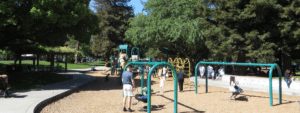Preparing for the city’s general plan update
Bruce England
Mountain View, like other cities in Silicon Valley, is taking action to recast itself as a green and sustainable place to live and do business, a city that can be an impressive model for the region.
At least this is what the members of the Mountain View Coalition for Sustainable Planning, a newly formed community group, hope to see accomplished through ongoing city planning processes.
From agricultural to post-war industrial, Mountain View has experienced a number of interesting evolutions over time, and many hope it will evolve into a more user- friendly, sustainable region in the years to come. However, any changes Mountain View considers must overcome a number of challenges posed by certain infrastructure realities created by past design decisions. For example, highways and expressways cut through town and create barriers between neighborhoods, existing policies often favor cars to the detriment of bicycle or pedestrian travel, the Peninsula rail system dissects the city (and this is further complicated by plans to add high-speed rail to the mix), and high-density community design has all too often been equated with low-quality design and construction. As one essential means for moving Mountain View from the past into the future, the city government is currently updating its general plan, a key planning document that was last updated in 1992 and will be completed in its updated form in 2010. And environmental sustainability impacts are, for the first time, required for inclusion in the general plan. While developing general plan updates correctly and comprehensively is always essential, given the multiple layers involved this time around for Mountain View, the importance of getting it right through the present cycle is especially critical. Those who are familiar with the process, and those who have been attending the numerous community meetings as of late, are learning that the Mountain View of 1992 and earlier and the Mountain View of 2009 and beyond are distinctly different cities. In response to this, dramatically fresh visions are being introduced.
Aside from the general plan updates currently taking place, Mountain View already has implemented or is considering infrastructure developments that will make the city an increasingly sustainable and compelling place. For example, Mountain View now includes:
- An extensive network of bikeable and walkable trails, most notably the Stevens Creek Trail;
- A strong environmental sustainability advocacy community, established by Mountain View Cool Cities and the mayor-appointed City of Mountain View Mountain View Environmental Sustainability Task Force, and continuing with Green Mountain View;
- Increased commitments on the part of the city to move operations in more green directions;
- GoogleWiFi, the free metro wireless system that Google established and continues to maintain and expand throughout the city.
This is a fortuitous time for new planning to be undertaken due to the likelihood that economic recovery in the area — estimated by some to begin sometime during late 2010 — will be stronger than state or national averages. This means that the quantity of good affordable housing will need to keep pace with the number of new jobs likely to become available, bringing with them new Mountain View residents.
Ellie Casson is the campaign organizer in Mountain View for the Greenbelt Alliance, a regional organization that promotes smart growth options throughout the Bay Area. She has been contacting and speaking with decision makers, planners, and stakeholders in the community. Casson quickly determined that all of these key people— as well as residents, visitors, and those doing business in the city— need to participate in equal standing with the Greenbelt Alliance in order for her to be effective and have adequate credibility.
Additionally, Casson realized that com-munity involvement with the general plan update process was well estab-lished, and she needed to draw from all sectors of the community in order to achieve a successful outcome.
“ I am so impressed by the degree of knowledge, involvement, and engagement that I’ve seen and experienced here,” said Casson. “ It would be a huge mistake on my part if I didn’t reach out to community members in Mountain View to learn as much as I possibly can. The kind of nuanced knowledge that local residents have is not something I could learn in a few months. That kind of expertise is invaluable to the work I’m trying to do in Mountain View.”
Accordingly, she sought out those who might work together to develop the necessary strategic framework. As a result of several organizational meetings Casson and others held this summer, a new group was formed under the name Mountain View Coalition for Sustainable Planning (MVCSP). Members represent a broad scope of local interests, including Green Mountain View, Advocates for Affordable Housing, Friends of the Stevens Creek Trail.
“Greenbelt Alliance’s goals of focusing growth in urban areas and protecting iconic landscapes will make the San Francisco Bay Area a model for how the nation can grow greener and live better.”
— Congresswoman Nancy Pelosi, Speaker of the House
###




